|
|
|
DA24QS - Audio
Digital to Analog Converter 24 Bit /
192 kHz (Quad Speed)
DA24DS - Audio Digital to Analog Converter 24 Bit / 96 kHz (Double
Speed)
|
|
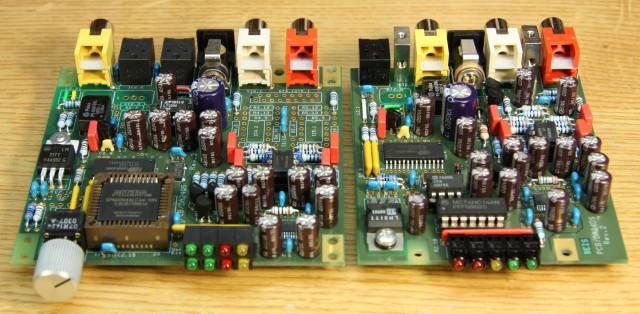 Click to enlarge |
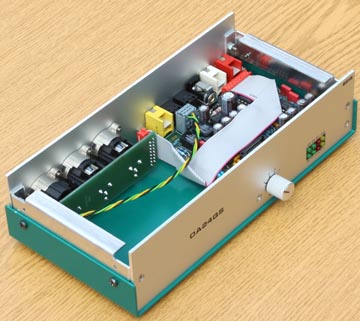 Click to enlarge |
|
|
|
|
|
|
DA24QS - Audio
Digital to Analog Converter 24 Bit /
192 kHz (Quad Speed)
DA24DS - Audio Digital to Analog Converter 24 Bit / 96 kHz (Double
Speed)
|
|
 Click to enlarge |
 Click to enlarge |
|
|
|
The DA24QS and DA24DS are 24 bit high quality Audio Digital to Analog Converter available as kit for DIY (Do It Yourself).
Both are based on the same "audio quality determining" circuitry and thus share the same technical audio data.
In detail both DACs feature:
| DA24QS | DA24DS | |||
| Sample Rate Range | 30 - 216 kHz | 30 - 108 kHz | ||
| Digital Audio Inputs |
2 x on-board optical (Toslink, up to 96 kHz only) 1 x on-board coaxial (RCA jack), 75 Ω Option: External AES3 XLR balanced, 110 Ω |
1 x on-board optical (Toslink) 1 x on-board coaxial (RCA jack), 75 Ω |
||
| Input Selector | 4 position rotary switch |
Automatically when an input signal at the optical input is present |
||
| Analog Outputs |
On-board Stereo (RCA jack), 100 Ω Option: External XLR balanced, 200 Ω |
On-board Stereo (RCA jack), 100 Ω | ||
| Output Level @ 100% FS |
On-board Stereo (RCA jack): 2 VRMS Option "External XLR balanced": +16 dBu (4.91 VRMS) Others as option |
On-board Stereo (RCA jack): 2 VRMS | ||
| Deemphasis |
When the emphasis bit is set: CD type (50/15 µs) in consumer format J-17 (333/38.5 µs) in professional format |
None | ||
|
Dynamic Range 20 Hz - 20 kHz |
114 dB unweighted, typically 117 dB A-weighted, typically |
114 dB unweighted, typically 117 dB A-weighted, typically |
||
| THD | t.b.d. | t.b.d. | ||
| Frequency Response |
2 Hz - SR / 2 +0 / -3 dB Except 192 kHz SR: 2 Hz - 85 kHz +0 / -3 dB |
2 Hz - SR / 2 +0 / -3 dB | ||
| Power Supply Rejection Ratio | approx. 93 dB @ 100 Hz | approx. 93 dB @ 100 Hz | ||
| Power Supply | 12 V DC, 200 - 300 mA approx. | 12 V DC, 100 - 150 mA approx. | ||
| Board Size | 91.44 mm x 88.27 mm (3.6" x 3.475") | 73.66 mm x 88.27 mm (2.9" x 3.475") | ||
| Mechanical Drawing | GIF file or PDF file | GIF file or PDF file | ||
The DA24QS operates over a wide range of sample rates. The S/PDIF receiver-IC (Cirrus CS8416) is specified from 30 kHz up to 216 kHz, but my sample works even with 16 kHz from the AD24QS (though, at 16 kHz, with a remarkably low SNR at the audio outputs). Due to its simplified circuit diagram the DA24DS does not support the quad speed range.
On both DACs at least one of the LEDs is always lit, so there is no Power-LED provided.
On the DA24QS 8 LEDs on the front indicate a couple of operational states:
Green: Sample Rate < 55.33 kHz (Single Speed, SSpd)
Green: Sample Rate > 55.33 kHz and < 110.67 kHz (Double Speed, DSpd)
Green: Sample Rate > 110.67 kHz (Quad Speed, QSpd)
Green: Professional Format (Pro)
Red: Receive Error or No Signal (Err)
Red: No Linear PCM Audio (i.e., the digital signal is a surround sound signal or something like that, NoAu)
Yellow: Copyright Asserted (Copy)
Yellow: Emphasis Signalled (Emph)When no digital audio signal is present, the LEDs "Double Speed" and "Receive Error" are lit.
On the DA24DS 5 LEDs on the front indicate a couple of operational states:
Red: Receive Error or No Signal (Err)
Red: No Linear PCM Audio (i.e., the digital signal is a surround sound signal or something like that, NoAu)
Yellow: Sample Rate. "On" when SR >= 88.1 kHz, "Off" when SR <= 48 kHz (Double Speed, DSpd)
Green: Digital audio signal from the optical (Toslink) input is selected (Opt.)
Green: Digital audio signal from the coaxial (RCA) input is selected (Coax)When no digital audio signal is present, the LEDs "Receive Error", "Double Speed" and "Coaxial Input" are lit.
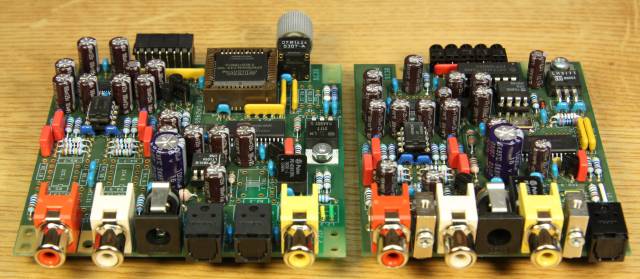 All
connections are made on the rear. When no digital audio signal
is present, both DACs generate their own digital "zero"
audio signal at a rate of 96 kHz.
All
connections are made on the rear. When no digital audio signal
is present, both DACs generate their own digital "zero"
audio signal at a rate of 96 kHz.
DA24QS: Up to 4 inputs are selected with the rotary switch on the front panel. On-board there are 3 digital audio inputs: Input 1 and 2 are optical (Toslink) ones and input 3 is an unbalanced, transformer-coupled RCA input. A 4th balanced digital audio input with its own digital audio transformer is included in the version DA24QS-IOP or can be connected externally.
DA24DS: On-board there are 2 digital audio inputs: Input 1 is an optical (Toslink) and input 2 is an unbalanced, transformer-coupled RCA input. The inputs are selected automatically: When an input signal at the optical input is detected, this input is enabled, otherwise the coaxial input is selected.
Both DACs provide unbalanced on-board (RCA jack) audio outputs with 2 VRMS at 100% FS, a usual level e.g. for CD or DVD players.
For the DA24QS as options, balanced outputs are prepared for XLR-connectors carrying output levels of 4.91 VRMS at 100% FS, which corresponds to +16 dBu or 12 dB above the standard studio level of +4 dBu (i.e, the headroom is 12 dB). They need extra balancing output amplifiers to be placed. On the photo you see these amplifiers and the Micro-Match connector for the balanced outputs populated, but the XLR-connectors are not connected. See the DA-IOP or DIY section for details how to connect XLR connectors.
The power supply is 12 V DC for both devices. The DA24QS's current consumption is from 200 mA (low sample rate, no audio signal) up to almost 300 mA (192 kHz, full scale sine wave signal), so the DA24QS gets warm. The DA24DS's current consumption is approximately half as much.
BTW, the DA24QS's 3.3 V regulator (LM317) gets quite warm, about 60°C (140°F) above ambient temperature. Maybe you'd call it even hot, but you can still touch the plastic housing for a couple of seconds. This is normal and far away from being critical. For mechanical reasons I do not recommend to provide an extra heat sink but I recommend to screw the LM317 onto the PCB as intended.
I recommend to use regulated power supplies because due to the hum of unregulated ones in spite of the DACs' quite high power supply rejection ratios the remaining hum in the output signal might noticeably decrease their dynamic range (unweighted measurements). BTW, I measured a dynamic range of approx. 109 dB for the DA24QS supplied by a full-wave rectified 9 V transformer (i.e., without buffer capacitor). 111 dB can be expected for the DA24DS. Even the use of a bare 9 V AC supply (which is possible, too) leaves about 105 dB (unweighted!).
For
the current circuit diagram of the DA24QS, have a look
at either the GIF-file or the
PDF-file.
For the current circuit diagram of the DA24DS, have a look at either the GIF-file or the PDF-file.
I use a Cirrus Logic CS8416 "192 kHz Digital Audio Interface Receiver" in hardware mode. For the Quad Speed version DA24QS the CS8416's hardware mode provides not quite enough functionality, i.e., signal outputs from control, for my goals. To overcome this, in the DA24QS I introduced a more complex control CPLD. Four digital audio inputs can be selected by the receiver's input multiplexer. On-board are two optical input devices (Toslink TORX147PL) as well as one unbalanced electrical output (0.5 VPP @ 75 Ω terminated) provided. Moreover, the DA24QS can be equipped externally with a professional digital audio input, either balanced (XLR, AES3, 2 VPP @ 110 Ω terminated) or unbalanced (BNC, AES-3id, 1 VPP @ 75 Ω terminated). The decoupling transformer and the termination resistors are provided on board.
The optical input device (the obsolete TORX147PL or its replacement PLR135) is specified up to slightly more than 96 kHz only, though it works on the workbench up to 192 kHz without any problems. Anyhow, I do not recommend to use it for 192 kHz.
The digital audio transformer for the coaxial signal is not specified for 192 kHz either, but when you have a look at its frequency response or its pulse transmission characteristics you understand why I unscrupulously use and recommend it. It would be fine for even much, much higher frequencies than 192 kHz.
The supply voltage for the receiver's PLL is regulated to 3.3 V by a precision TL431 shunt regulator. This was one of the lowest noise regulators I found, but I experienced that noise almost does not matter at all because the reference voltage noise is very well filtered by the receiver's external filter components, just like in the ADC's and DAC's reference supplies.
The CS4398 is Cirrus Logic's "Flagship" delta sigma D/A converter, specified with 120 dB dynamic range. The reference supply is a simple 78L05A, but there is no reason for concerns about its noise as reference voltage noise is very well filtered by the DAC's external filter components.
Unlike in the AD24QS, in the DACs the only analog stage is not designed fully balanced. This stage is a 2nd order low-pass Butterworth filter with a corner frequency of 100 kHz approx. and a differential input and a single ended output, supplying the unbalanced signal for the RCA output jacks. In order to maintain the extreme high dynamic range I use an extra low-noise (and expensive) op-amp LM4562. Also, the filter network resistors must on one hand be as low as possible to generate as less noise as possible, but on the other hand they must not overload the DAC's output. Note, that the values of the filter's passive components are not symmetrical. This is because only by this way the CS8416's balanced outputs are loaded equally.
The DA24QS can be equipped with external professional, balanced audio outputs (XLR). For this purpose the additional balanced output op-amp stages (IC4.2 and IC5.2) needs to be populated along with the Micro-Match (or compatible) connector for the balanced outputs. On the photo above you can see the position for the optional output stages and the Micro-Match connector, but it is not populated there. Balanced outputs including XLR connectors and more are included in the kit DA24QS-IOP.
The logic for the DA24QS is much more complex than the one for the AD24QS. Most important is the need for a sample rate detector. The DAC-IC (CS4398) must be supplied with an information whether it operates at single, double or quad speed. For this "frequency range detector" I chose an EPM3064, a CPLD in a 44-pin PLCC-package with 64 macrocells from Altera. This CPLD also takes up some more functions like extracting the "Professional", the "Copyright" and the "Emphasis" bits from the control data stream, controlling the emphasis function of the CS4398, generating a power-up reset signal and finally driving all 8 LEDs. The CPLD is not too expensive and in kits you'll get them programmed, of course.
Emphasis, by the way, does not work in quad speed mode, because the CS4398 is not capable of that. Emphasis in quad speed mode will be indicated, but not "executed".
There are a couple of components for the reset circuitry not populated. They were intended in case the CPLD provides a buffer for a reset generator only, but in the EPM3064 currently (just) enough macrocells for a 0.3 s reset timer are remaining, so these components are not needed.
One major issue I attached importance to is that the DACs do not produce noise when the S/PDIF input signal is missing. In other concepts, like in the DA24QS's predecessor DA2496, without a digital input signal the S/PDIF-PLLs tune to very low frequencies. Because DAC-ICs run at that frequency, too, the DAC's noise-shaped spectrum starts to rise at such low frequencies that a clearly audible amount of this noise shifts into the audible band. In both DACs (DA24QS and DA24DS), without an S/PDIF input signal, the word clock is switched to slightly more than 96 kHz, derived by the S/PDIF receiver IC from a 25 MHz crystal oscillator.
The nominal supply voltage for the device is 12 V, but up to 15 V are allowed and it operates down to 10 V or less. The power input is protected against polarity reversal and buffered with an extra large 1000 µF capacitor .
The digital parts of the DACs operate at 3.3 V, only the analog output of the DAC-IC operates at 5 V. I provided a linear regulator, an LM317 in a TO220-package, to regulate the digital supply voltage. As in the DA24QS (in contrast to the DA24DS) the current consumption on the 3.3 V rail is quite high and the voltage drop is quite high, too, the LM317 gets quite hot, i.e., you can touch it for a few seconds only.
Like in the AD24QS, the negative analog supply voltage is generated by a DC-DC voltage inverter (for the DA24QS an LT1054, up to 15 V / 100 mA, and for the DA24DS an ICL7660S, up to 13 V / 20 mA) and both the positive and the negative analog supply voltages are smoothed by one low-pass emitter follower each.
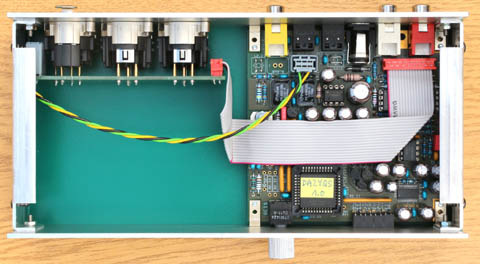
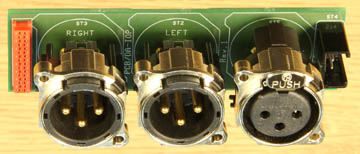 DA-IOP
DA-IOPThe DA-IOP (Input/Output Passive module) is part of the kit DA24QS-IOP. It is a small PCB which provides for the DA24QS:
The DA24QS and the DA-IOP are connected with each other by
Both cables are prepared and intended to be used as on this photo.
For different reasons I am allowed to sell these converters as kits and thus for DIYs only. In case you need assembled and tested versions, please have a look here.
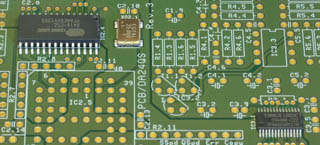 Is
it difficult?
Is
it difficult?I expect sufficient experience from people to assemble the kits. I don't explain how to read resistor values, how to discriminate a 100 µH inductor from a 100 Ω resistor, which components are polarized, on which side the soldering iron gets hot and so on.
I don't find it to be really difficult to solder normal SO-IC packages, but the CS4398's TSSOP package is not that easy. Anyway, on the newest kits all 3 SMD components (CS4398, CS8416 and the 25 MHz oscillator) are already soldered.
What even happens to me is that I mix up similar looking resistors, put components in the wrong places, rotate ICs by 180° or forget to solder all joints. Usually all this soon becomes quite obvious and can easily be corrected.
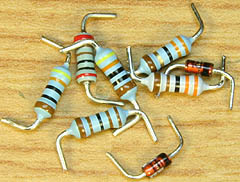 Kits
KitsThe kits I provide come with all necessary electronic and mechanical parts for the DACs. I.e., the DA24DS-K is complete, the DA24QS-K is the DA24QS's basic version (no 4th digital audio input, no balanced analog outputs), the DA24QS-B includes balanced analog outputs (but without XLR or TRS jacks) and the DA24QS-IOP includes balanced analog outputs as well as an AES3 input, all with XLR jacks. The DA24QS's CPLD is programmed. The kits come without an enclosure, front or rear panel but a 12 mm aluminum knob for the DA24QS is included - just as you can see on the photos.
See the BOM (bill of material) for what is actually included in the different kit versions.
Normally all axial components, i.e., resistors, diodes and inductors, come cut and bent. This saves a lot of assembly time for you and may help that the assembly looks neater. Not all components on the board need to be populated. They are partially intended for options. Which one is to be populated and where is shown in the assembly drawings.
4 jumpers, indicated red in the assembly drawing, must be placed at L1.1 and L2.2. For these slightly longer wires (5 mm) I prefer colored insulated ones because it looks better.
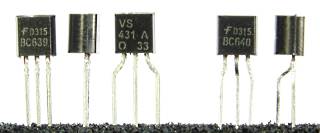 Preparing
the TO92 Cases
Preparing
the TO92 CasesThe photo on the right shows how to prepare the transistors and ICs in TO92 cases. Unfortunately I cannot easily get the leads bent as originally planned, so they must be bent correctly by hand during assembly. I intended the pad layout in a triangular shape with 0.1" (2,54 mm) pitch. Today most TO92s come with all leads close to each other in one row (both left transistors) or, quite exotic, like the TL431 in the middle.
Do not force TO92s with such unsuitable leads into their holes!
Try to bend them like the rightmost ones which I bent manually. Each lead is bent twice. Do not bend the leads directly at the case because the case as well as the leads would be very much stressed and endangered. After bending, they should more or less "fall" into their three holes in the PCB.
Find here the assembly drawings:
|
|
|
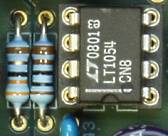
|
||
|
|
||||
| Indicating the component names | Indicating the component types or values | Photo of the component side | ||
|
|
||||
| Indicating the component names | Indicating the component types or values | Photo of the component side | ||
|
|
||||
| Indicating the component names | Indicating the component types or values | Photo of the component side | ||
|
|
||||
| Indicating the component names | Indicating the component types or values | Photo of the component side | ||
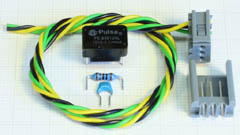 Balanced
AES3 Input: For the balanced digital audio input another
digital audio transformer, a pin header and a few passive components
are needed. The option "Set for AES3 input" contains
them all as you can see on the right hand photo (Note: This and
more is included in the DA24QS-IOP).
Balanced
AES3 Input: For the balanced digital audio input another
digital audio transformer, a pin header and a few passive components
are needed. The option "Set for AES3 input" contains
them all as you can see on the right hand photo (Note: This and
more is included in the DA24QS-IOP).
Balanced Outputs: The kit DA24QS-B includes the op-amps and passive components, the Micro-Match connector and the appropriate ribbon cable for balanced analog outputs as you can see on the photo below. (Note: This and more is included in the DA24QS-IOP). In case you want to connect XLR connectors or TRS jacks yourself you have to wire the on-board connector ST3.1:
| Signal | XLR | TRS | Left Out | Right Out | |||||
| Ground | Pin 1 | Sleeve | Pin 4 | Pin 14 | |||||
| Pos. | Pin 2 | Tip | Pin 5 | Pin 15 | |||||
| Neg. | Pin 3 | Ring | Pin 3 | Pin 13 |
EMC chokes: For an improved EMC (electro-magnetic compatibility) the board is prepared for two common mode chokes, L1 and L3. One is for the power supply input, the other one for the unbalanced, digital audio input. I pay attention to EMC performances but I am not able to test them. I prepared the chokes "just in case". Under normal circumstances they are not required.
Anyway, the DAC should always be installed into a well shielding enclosure!
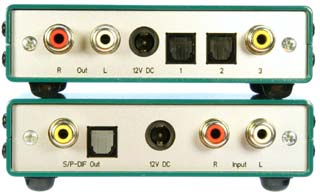
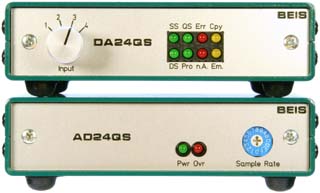 For
my units I used an SG 206
or SG 210
resp. enclosure from the (German) company Fischer
Elektronik. In contrast to the pictures you see here, these
enclosures are no longer available in opal green from the manufacturer.
I still stock SG 206 in opal green (SG 206 GO),
but the SG 210 now comes in black (SG 210 S).
For
my units I used an SG 206
or SG 210
resp. enclosure from the (German) company Fischer
Elektronik. In contrast to the pictures you see here, these
enclosures are no longer available in opal green from the manufacturer.
I still stock SG 206 in opal green (SG 206 GO),
but the SG 210 now comes in black (SG 210 S).
Front panel, enclosure and board are directly fixed to each other using the element 5.60.422 (DA24QS) or element 5.60.723 (DA24DS) from the (German) company Ettinger, the first one is available from Bürklin.
You need not necessarily to use the enclosure I used. The board can easily be built into other enclosures. For this enclosure I provided detailed dimensional drawings:
You will see there how the board is fixed within the SG206 and how it can alternatively be fixed directly to other front panels. Of course you may also use four stand-offs, distance bolts or distance tubes to fix the board on the bottom of your enclosure. The drilling positions can be found in the dimensional drawing, too.
The mounting elements 5.60.422 are are intended to be used either standing (particularly in the SG 206 enclosure, left photo) or lying, e.g. in the SG 210 enclosure (right photo) or behind any other front panel.
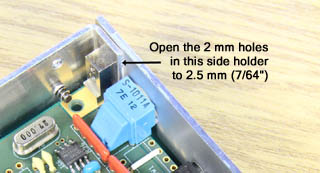 Click to enlarge |
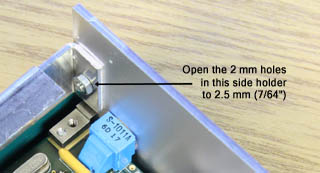 Click to enlarge |
|
|
|
|
The front and the rear panels shown above are manufactured by Schaeffer AG (in Europe) and are available in the US from Front Panel Express, LLC, too. You need the design files for these panels, then you just have to send them to the manufacturer and you'll get a perfectly milled and engraved panels, as the photos show. You may also modify the design files with the front panel design software "Front Panel Designer" German, English or French (it's free and very convenient) so that it fits to other enclosure of your choice.
All companies mentioned above have international branches, e.g. in the USA.
... is explained on page AD/DA24QS_Order.
| Last update: February 13th, 2024 | Questions? Suggestions? Email Me! | Uwe Beis |